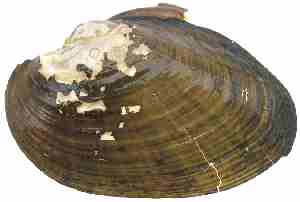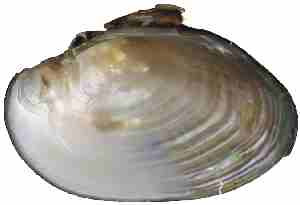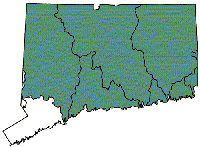Triangle Floater
Alasmidonta undulata
Key Features
Size: Up to three inches.
Shape: Subovate. Ventral margin rounded. Its laterally inflated valves and subovate shape give it a “plump” appearance. Beaks prominent.
Periostracum: Color yellowish-green (juveniles) to greenish-brown (adults) or black. Shell rays numerous.
Lateral Teeth: Absent.
Pseudocardinal Teeth: Present and well developed. The stout teeth are buttressed by a heavy ridge.
Nacre: Usually distinctly bicolored. Posterior half thin and an iridescent bluish-pink, and the anterior half thick and usually whitish-pink.
Often Confused With ... Dwarf wedgemussel, brook floater, creeper

External shell

Internal shell, right valve

Hinge teeth
 Habitat: The triangle floater is found in streams, rivers, and lakes, where it seems to prefer sand and gravel substrates. It is the only Alasmidonta species in Connecticut that can be found in lakes, though it is more commonly found in small to medium-sized rivers.
Habitat: The triangle floater is found in streams, rivers, and lakes, where it seems to prefer sand and gravel substrates. It is the only Alasmidonta species in Connecticut that can be found in lakes, though it is more commonly found in small to medium-sized rivers.
Range in Connecticut: The triangle floater exists in most watersheds in Connecticut, though it is particularly common in the Connecticut River watershed.
Conservation: The triangle floater is widespread in Connecticut and there are many large healthy populations. It seems to be less sensitive to pollution and habitat disturbance—and uses a broader range of host fish—than its close relatives, the brook floater and dwarf wedgemussel. It is an important indicator of river health, and may be declining in southern parts of its range, such as Maryland where it is listed as endangered. It is listed as special concern in Massachusetts and Maine.
Freshwater Mussel Fact Sheets
Eastern Pearlshell
Dwarf Wedgemussel
Triangle Floater
Brook Floater
Creeper
Eastern Elliptio
Eastern Floater
Alewife Floater
Eastern Pondmussel
Tidewater Mucket
Yellow Lampmussel
Eastern Lampmussel
The Freshwater Mussels of Connecticut
Content last updated on January 29, 2014.

